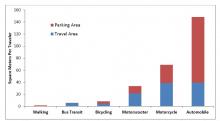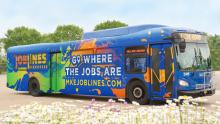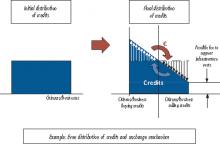
It is well understood that increased automobile use is linked to congestion, environmental degradation and negative health and safety impacts. Trials of smart parking technology has shown a reduction in circulating traffic (looking for parking) can ease congestion and that the cost of parking can influence commuters’ modal choice. Now, researchers at the universities of Wisconsin and Connecticut have shown that increases in the availability of parking lead to a rise in automobile use.
Previous studies had considered the employment end of the commute whereas this study set out to considering entire citywide systems of parking - both residential and commercial. Others had looked at the correlation between the cost of parking car use but according to Chris McCahill: “Where a city has a lot of parking, it can be hard to use pricing mechanisms because it’s so plentiful and undervalued. As parking becomes more restricted, pricing become more effective and makes more sense.”
McCahill is a senior associate at the State Smart Transportation Initiative of the University of Wisconsin and lead author of a paper on the subject given at the recent Transportation Research Board meeting in Washington. He says “The question our study asked was one of causality: do citywide changes in parking actually cause automobile use to increase, or are minimum parking requirements an appropriate response to already rising automobile use?”
In order to find some answers he, and fellow researchers (associate professors Norman Garrick, Carol Atkinson-Palombo and graduate researcher Adam Polinski from the University of Connecticut) applied the Bradford Hill criteria to the problem.
The Bradford Hill criteria, created by Sir Austin Bradford Hill, are designed for inferring causality when an association already exists and are most commonly used in the field of epidemiology - for instance to establish the cause/effect between smoking and lung cancer.
McCahill quotes Sir Austin saying: “The decisive question is whether the frequency of the undesirable event B will be influenced by a change in the environmental feature A.”
In this instance, the environmental feature ‘A’ is the parking supply, and the event ‘B’ refers to levels of automobile use.
“This approach lets us overcome the inherent challenges of many potential explanatory variables and a lack of reliable data for many of those variables. By approaching our question in this way we cannot discredit other factors, but we can gain a reasonably definitive answer regarding the potential citywide impacts of parking on travel behaviour. And from that we can make evidence-based policy recommendations to achieve long-term transportation-related goals.”
Currently most municipalities in the US set minimum parking requirements which are determined by estimating the potential demand and aiming to meet that demand (as laid out in the Institute of Transportation Engineer’s Parking Generation and other similar guides). However, McCahill says such methods do not account for the complex relationships between parking supply and demand: “Parking provision is expensive and drives up construction and rental prices. It consumes large amounts of space and so limits development potential – and there is evidence that automobile use increased considerably in cities where parking has been increased.”
To evaluate the cause and effect, the researchers selected nine medium-sized cities (from a database of more than 100) based on population size and changes in automobile use between 1960 and 2000. Populations in the selected cities range from approximately 100,000 to 300,000 and none have experienced marked population growth over the study period, indicating a stable infrastructure.
The cities represent a full range in automobile use, including some with exceptionally low automobile mode shares.
A primary source of data was the US Census Bureau which has undertaken a ‘Journey to Work’ survey every decade since 1960. Without a reliable database of parking supply, the researchers made estimates based on old aerial photographs that were taken as near as possible to the target years of 1960, 1980 and 2000.
McCahill explains: “We identified land used for off-street parking in geographic information systems (GIS) by visual inspection. This includes any visible off-street parking facility with more than three spaces, including multi-level parking structures. For older aerial photographs, we determined each city’s minimum and maximum parking area and reported the midpoint.
“In estimating the number of parking spaces, we divided the total area by 32.5m2 (350ft2) the average area per parking space. We multiplied the footprint of multistorey parking structures by four to estimate their rough capacity. Figures for 1960, 1980 and 2000 were estimated from values in known years using linear interpolation or projection.”
The Journey to Work census reports allowed the team to calculate the number of residents and employees commuting to or from each city and the automobile mode share for each year of interest while isolating local trips that begin and end within a city.
Before the Bradford Hill criteria can be used, first a clear association between treatment and outcome must be established. To do this the researched plotted the known relationship between parking provision (parking spaces per resident and employee) and automobile use (automobile mode share for workers) for each of the target years (see Figure 1). “We observe a clear, consistent association where R2 = 0.79 - which means that parking explains 79% of the variation in mode shares among the cities.
“For our study, we consider the association to be strong if the slope of the line is steep, indicating that changes in parking provision are associated with large changes in automobile use. The actual slope is 0.77, meaning that a change of 0.1 parking spaces per person corresponds with a difference in automobile mode share of 7.7%.
“If we consider cities with 0.2 parking spaces per person [which translates to 60% automobile use] as the control group, then cities with 0.5 parking spaces per person can expect 83% of commuters to travel by car. So in cities with 0.5 spaces per person [which includes residents and employees], individuals are 40% more likely to drive than where there are only 0.2 spaces per person.
“That is quite substantial in terms of urban automobile use and its related impacts.”
As shown in Figure 1, the relationship between parking provision and car use has held up fairly consistently over the 40-year study period in all the selected cities. The rates of automobile use are considerably higher in cities with most parking, and the relationship is exceptionally strong. “Where there are more than 0.4 spaces per person, more than 75% of commuters travel by car.”
Figure 2 shows that increases in the number of parking spaces per resident between 1960 and 1980 are directly correlated (R2 = 0.86) with increases in residents’ automobile use in the following two decades.
“We have provided compelling evidence that parking provision is a cause of citywide automobile use and calls into question the justification for basing minimum parking requirements on a predict-and-provide approach. If increased parking provision causes more driving, this effect should be taken into account and managed accordingly through mechanisms like maximum parking allowances and pricing.
McCahill concludes by saying: “Our findings warrant policies to restrict and reduce parking capacity in cities as a means of curbing high levels of automobile use.”
Defining factor
Traditional indicators such as income, car ownership, population and housing density, government employment and differences between drive and transit times to the central business district (CBD) predict a higher share of Park Slope residents will commute by car than those from Jackson Heights. Yet Jackson Heights’ residents are 45% more likely to drive to work in the Manhattan CBD and 28% more likely to commute by car.
The researchers say this is because Jackson Heights has considerably more off-street parking - residents are more than 2.5 times more likely to have off-street parking and six times as likely to have an on-site private parking space. The authors conclude that guaranteed parking at home is the only clear factor explaining the relatively high rates of automobile use in that neighbourhood.
International examples
A study in Edinburgh, Scotland, recorded considerably lower car use within a limited parking zone than outside, and estimated that a 2.5km (1.5mile) expansion of the zone could reduce commuting by car by 21%.
Surveys of travellers in Haifa, Israel, show that reductions in parking availability could prompt between 23% to 45% of workers (and 16% to 25% of non-workers) to change modes and were dependant on the increase in parking search times.







